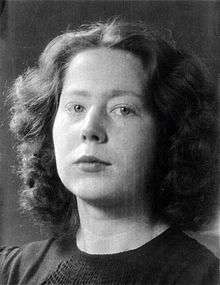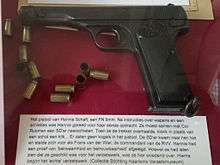Hannie Schaft
Jannetje Johanna (Jo) Schaft (16 September 1920 – 17 April 1945) was a Dutch communist resistance fighter during World War II. She became known as 'the girl with the red hair' (Dutch: Het meisje met het rode haar). Her secret name in the resistance movement was "Hannie".
Hannie Schaft | |
|---|---|
 | |
| Born | Jannetje Johanna Schaft 16 September 1920 Haarlem, Netherlands |
| Died | 17 April 1945 (aged 24) Bloemendaal, Netherlands |
| Nationality | Dutch |
| Other names | The girl with the red hair |
| Known for | Resistance fighter during World War II |
Early life and education
Hannie Schaft was born in Haarlem the capital of the province of North Holland.[1] Her mother, Aafje Talea Schaft (born Vrijer) was a Mennonite and her father, Pieter Schaft was attached to the Social Democratic Workers' Party; the two were immensely protective of Schaft because of the death of her older sister.[1]
From a young age, Schaft discussed politics and social justice with her family, which encouraged her to pursue law and become a human rights lawyer.[1] During her law studies at the Universiteit van Amsterdam she became friends with the Jewish students Philine Polak and Sonja Frenk. This made her feel strongly about actions against Jews. With the German occupation of the Netherlands in World War II, in 1943, university students were required to sign a declaration of allegiance to the occupation authorities. When Schaft refused to sign the petition in support of the occupation forces, like 80% of the other students, she could not continue her studies and moved in with her parents again.[2]
Resistance work

Schaft's resistance work started with small acts. First, she would steal ID cards for Jewish residents (including her friends).[1] Upon leaving university, she joined the Raad van Verzet or "Council of Resistance", a resistance movement that had close ties to the Communist Party of the Netherlands.[2] Rather than act as a courier, Schaft wanted to work with weapons. She was responsible for sabotaging and assassinating various targets.[2] She carried out attacks on Germans, Dutch Nazis, collaborators and traitors. She learned to speak German fluently and became involved with German soldiers.
Schaft did not, however, accept every job. When asked to kidnap the children of a Nazi official she refused. If the plan had failed, the children would have to be killed, and Schaft felt that was too similar to the Nazis' acts of terror.[3] When seen at the location of a particular assassination, Schaft was identified as "the girl with the red hair". Her involvement led "the girl with the red hair" to be placed on the Nazis' most-wanted list.[2]
When one of Schaft's friends and fellow Resistance workers was injured in an attempted assassination effort, the friend mistakenly gave Schaft's name to Dutch Nazi nurses disguised as Resistance workers. To force Schaft to confess, German authorities arrested her parents and sent them to the Vught concentration camp.[4] The distress of this situation forced Schaft to cease resistance work temporarily; her parents were eventually released.[4]
Upon recovery, Schaft dyed her hair black to hide her identity and returned to Resistance work. She once again contributed to assassinations and sabotage, as well as courier work, and the transportation of illegal weapons and the dissemination of illegal newspapers.[4]
Death

She was eventually arrested at a military checkpoint in Haarlem on 21 March 1945 while distributing the illegal communist newspaper de Waarheid (literally 'The Truth'), which was a cover story. She was transporting secret documentation for the Resistance. She worked closely with Anna A.C. Wijnhoff.[5] After much interrogation, torture, and solitary confinement, Schaft was identified by the roots of her red hair by her former colleague Anna Wijnhoff.[5]
Schaft was executed by Dutch Nazi officials on 17 April 1945.[5] Although at the end of the war there was an agreement between the occupier and the Binnenlandse Strijdkrachten ('Dutch resistance') to stop executions, she was shot dead three weeks before the end of the war in the dunes of Bloemendaal. Two men took her there and one shot her at close range, only wounding her. She is said to have told her executioners: Ik schiet beter "I shoot better!", after which the other man delivered the final shot.[5]
On 27 November 1945, Schaft was reburied in a state funeral. Queen Wilhelmina called Schaft "the symbol of the Resistance".[5]
Legacy
_1962%2C_MiNr_0883.jpg)
After the war, the remains of 422 members of the resistance were found in the Bloemendaal dunes, 421 men and one woman, Hannie Schaft. She was reburied at the honorary cemetery Erebegraafplaats Bloemendaal in the dunes in Overveen in the presence of Princess Juliana and her husband Prince Bernard. Later, as queen, Juliana unveiled a bronze commemorative statue in the Kenau Park in nearby Haarlem, her birthplace. Schaft was one of 95 people to receive the Dutch Cross of Resistance and General Eisenhower awarded her a decoration, possibly the Medal of Freedom.[6]
Shortly after the war, the communist movement enjoyed popularity, partly because of the effort of the USSR in defeating the Nazis. However, with that country's increasing influence in Eastern Europe, the popularity decreased. Because the Dutch communist party celebrated her as an icon, her popularity decreased too, to the point that the commemoration at Hannie's grave was forbidden in 1951.[5] The commemorators (who were estimated to number over 10,000) were stopped by several hundred police and military with the aid of four tanks. A group of seven managed to circumvent the blockade and reached the burial ground, but were arrested when they tolled the bell. From the next year on, the communists decided to prevent another such scene by holding their commemoration in Haarlem instead.
A number of schools and streets were named after her. For her, and other resistance-heroines, a foundation has been created; the National Hannie Schaft Foundation (Dutch: Nationale Hannie Schaft Stichting).[7][8] A number of books and movies have been made about her. She features in The Assault (De Aanslag, 1982) by Harry Mulisch, also released as a movie directed by Fons Rademakers. Ineke Verdoner wrote a song about her. Author Theun de Vries wrote a biography of her life, which has inspired the movie The Girl with the Red Hair (Het Meisje met het Rode Haar, 1981) by Ben Verbong featuring Renee Soutendijk as Hannie Schaft. She is remembered each year in November during a national event held in Haarlem.[9]
In the early 1990s, thanks to the Hannie Schaft Memorial Foundation, commemorations were once again permitted. The last Sunday of each November in the Netherlands is a day of remembrance for Schaft's life and work.[10]
References
- Atwood, Kathryn J. (2011). Women Heroes of World War II. Chicago: Chicago Review Press. p. 103. ISBN 9781556529610.
- Atwood, Kathryn J. (2011). Women Heroes of World War II. Chicago: Chicago Review Press. p. 104. ISBN 9781556529610.
- Atwood, Kathryn J. (2011). Women Heroes of World War II. Chicago: Chicago Review Press. p. 105. ISBN 9781556529610.
- Atwood, Kathryn J. (2011). Women Heroes of World War II. Chicago: Chicago Review Press. p. 106. ISBN 9781556529610.
- Atwood, Kathryn J. (2011). Women Heroes of World War II. Chicago: Chicago Review Press. p. 107. ISBN 9781556529610.
- Erik Müller, Schaft, Jannetje Johanna at onderscheidingen.nl
- "Nationale Hannie Schaft Stichting" (in Dutch). Retrieved 28 May 2020.
- "Freddie Oversteegen, Gritty Dutch Resistance Fighter, Dies at 92".
- "Herdenkingen". Eerebegraafplaatsbloemendaal.eu. Retrieved 2014-04-07.
- Atwood, Kathryn J. (2011). Women Heroes of World War II. Chicago: Chicago Review Press. p. 108. ISBN 9781556529610.
External links
![]()